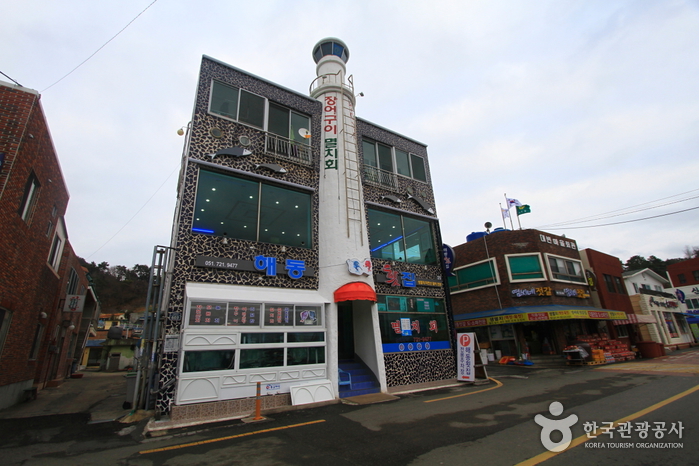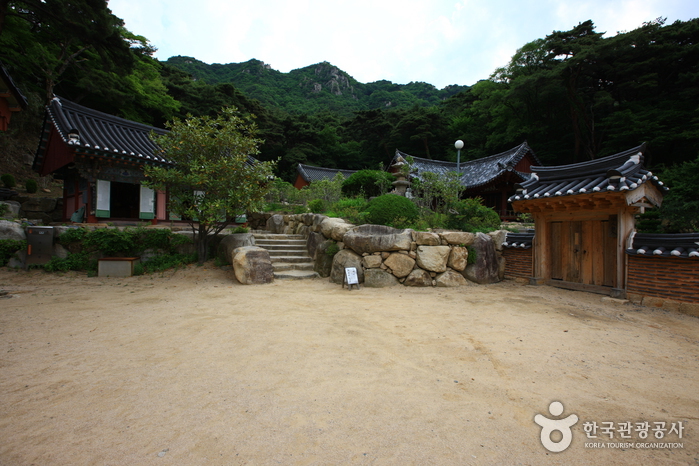Eulsukdo Migratory Bird Park (을숙도 철새공원)
15.3Km 2021-04-23
1240, Nakdongnam-ro, Saha-gu, Busan
+82-51-209-2031
Eulsukdo Migratory Bird Park, designated as Natural Monument No. 179, is located in the lower part of Elsukdo Island. Renovated in 2009, the park is the central area for migratory bird habitats and ecology tourism. In winter, migratory birds can be seen at the wetlands. Nakdong Estuary Eco Center in the park provides information on various eco-life of the area as well as treat injured wild animals.
Yeongdo Lighthouse (영도 등대)
15.4Km 2024-03-06
181, Jeonmang-ro, Yeongdo-gu, Busan
+82-51-405-1201
Yeongdo Lighthouse, first lit in 1906, stands at Taejongdae Park. It houses a maritime library, galleries, an observatory, and a café. From the observatory, on clear days, you can even see as far as the Japanese island of Tsushima Island. At the base of the lighthouse, there's a sculpture of a woman turned into stone, waiting for her husband who went out to sea. You can reach it by walking from Taejongdae Park or taking the Taejongdae Danubi Train.
Jangnim Port (장림포구)
15.6Km 2023-02-06
72, Jangnim-ro 93beon-gil, Saha-gu, Busan
+82-51-220-4502
Jangnim Port is a trending place in Busan that has gained popularity through word of mouth on social media. Administratively, it belongs to Jangnim-dong, Saha-gu, and the name of the port is Jangnim Port after the neighborhood. Because the colorful buildings and small boats floating along the port resemble Venice's Murano Island, its nickname is "Bunezia," meaning Busan's Venice. Due to its beautiful sunset and location on the way to Dadaepo Beach, Jangnim Port has emerged as a new summer resort in Busan, as it is possible to tour in connection with the Amisan Observatory and the Dadaepo Sunset Fountain of Dreams.
Haedong Hoetjip (해동횟집)
15.6Km 2019-11-19
603, Gijanghaean-ro, Gijang-gun, Busan
+82-51-721-9477
Raw anchovy is the specialty at Haedong Hoetjip located near Daebyeon Port. While having raw fish, one can enjoy views of the sea through the window.
Gimhae Eunhasa Temple (은하사(김해))
15.6Km 2021-02-24
167, Sineosan-gil, Gimhae-si, Gyeongsangnam-do
+82-55-337-0101
Eunhasa Temple is located in Sineosan Mountain in Gimhae, Gyeongsangnam-do. The year it was founded remains unknown, but legend has it that Monk Jangyuhwasang built the temple in AD 1, before the nationwide spread of Buddhism. However, relic pieces found at the temple site indicate the possibility of the temple's establishment in the Three Kingdoms Era. The temple was once burned down together with Dongnimsa Temple during the Imjin War and the architectural design seen today is that of the late Joseon dynasty.
Artbox - Yangsan Mulgeum Branch [Tax Refund Shop] (아트박스 양산물금점)
16.0Km 2024-06-26
72, Beomero-ro, Mulgeum-eup, Yangsan-si, Gyeongsangnam-do
-
ET Land - Mega Mart Gijang [Tax Refund Shop] (전자랜드 메가마트기장)
16.1Km 2024-04-22
673, Gijang-daero, Ilgwang-eup, Gijang-gun, Busan
-
Mega Mart - Gijang Branch [Tax Refund Shop] (메가마트 기장점)
16.1Km 2024-04-23
673, Gijang-daero, Ilgwang-eup, Gijang-gun, Busan
-
Bunsanseong Fortress (김해 분산성)
16.2Km 2023-01-18
210-162, Gaya-ro 405beon-gil, Gimhae-si, Gyeongsangnam-do
+82-55-330-3925
Bunsanseong Fortress was constructed in the 3rd year of the reign of Goryeo's King U (1377) by Magistrate Park Wi to defend against foreign enemies, but it was destroyed during the Japanese invasion of 1592. The fortress we see today was reconstructed by Magistrate Jeong Hyeon-seok in the 8th year of the reign of Joseon's King Gojong (1871). However, it is estimated that it was first built during the days of Gaya. It is a temoe-style fortress with rocks piled up like a long band at the peak of Bunsan from which downtown Gimhae, Gimhae Plains, the Nakdonggang River and the South Sea are all in a single, panoramic view. Today, fortress walls remain stretching for some 900 meters on the slope towards the city and, inside the fortress, there are two gate sites in the south and north, an auxiliary gate on the west, a well site and several other building sites. The exact length of the remaining fortress walls is 929 meters and the average x_width is about 8 meters.
Inside the fortress lies Haeeunsa Temple, which was built to pay respects to Queen Heo of Garak who had come from the sea, according to stories. The temple also enshrines portraits of King Suro and Queen Heo that were painted during the Joseon dynasty. During the Japanese invasion of 1592, monk soldiers were stationed at this temple.
The fortress is more popularly called "Manjangdae" by Gimhae locals, and this name originated from the description, "A tall tower 10,000 (man) gil in x_height," granted by Daewongun in the Joseon dynasty for this advanced base that defeats Japanese invaders. A writing of "Manjangdae" written by Daewongun himself as well as his stamp are engraved on a rock behind a beacon that was restored in 1999.
Topten - ISQUARE Mall Branch [Tax Refund Shop] (탑텐 김해아이스퀘어)
16.3Km 2024-04-18
I Square Mall West Block, 2342, Gimhae-daero, Gimhae-si, Gyeongsangnam-do
-



![Artbox - Yangsan Mulgeum Branch [Tax Refund Shop] (아트박스 양산물금점)](http://tong.visitkorea.or.kr/cms/resource/39/3312839_image2_1.jpg)
![ET Land - Mega Mart Gijang [Tax Refund Shop] (전자랜드 메가마트기장)](http://tong.visitkorea.or.kr/cms/resource/36/2884636_image2_1.jpg)
![Mega Mart - Gijang Branch [Tax Refund Shop] (메가마트 기장점)](http://tong.visitkorea.or.kr/cms/resource/33/2884633_image2_1.jpg)
![Topten - ISQUARE Mall Branch [Tax Refund Shop] (탑텐 김해아이스퀘어)](http://tong.visitkorea.or.kr/cms/resource/43/2885943_image2_1.jpg)
 English
English
 한국어
한국어 日本語
日本語 中文(简体)
中文(简体) Deutsch
Deutsch Français
Français Español
Español Русский
Русский